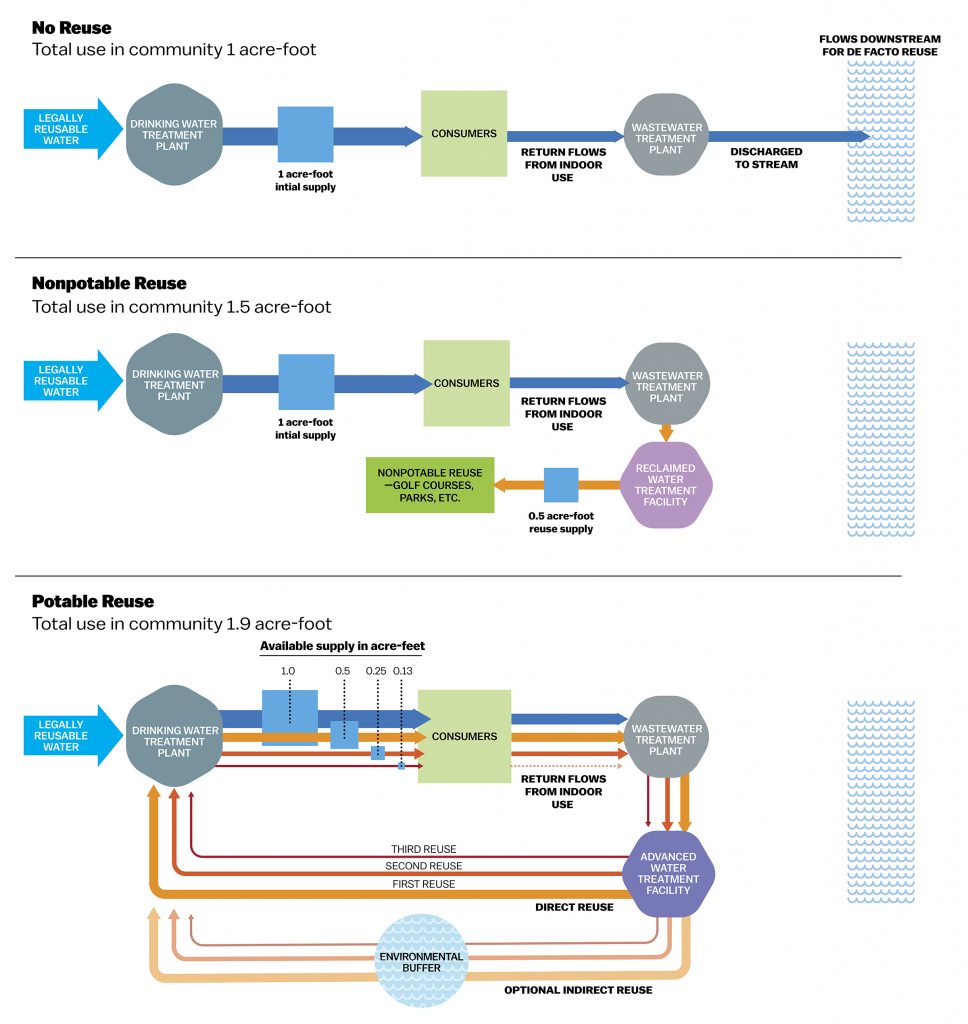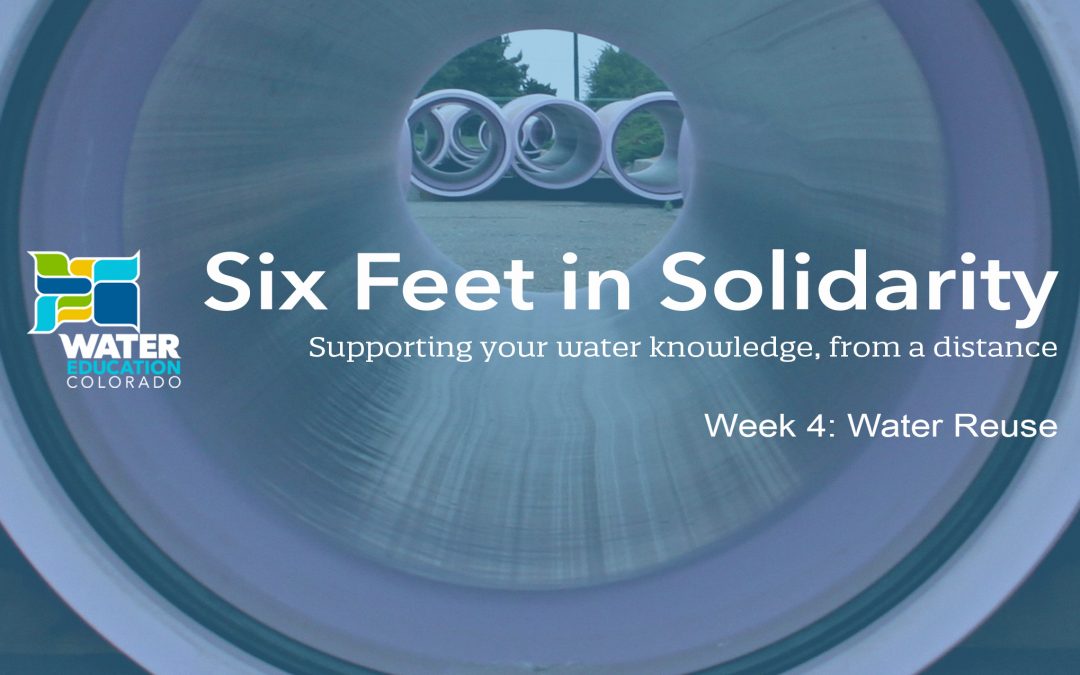We’ve been sending a new weekly “Six Feet in Solidarity” email on Thursdays to keep you company! Our hope is to stay connected and continue serving up resources to build your water knowledge around different topics for as long as social distancing lasts.
We’ll be pulling from our library of publications, news stories, webinars, videos, radio programs, and more, and also sharing key resources produced by others in the water community. If you have ideas, please share at info@wateredco.org.
Thus far we’ve sent emails focused on land use and water, stream management plans in Colorado, and environmental justice and equity in the water sector. This week we’ll look at water reuse. Read on to learn more. And continue to be well!
The Promise of Reuse

Photo By: Matthew Staver
For decades, Colorado has been recycling water for landscaping purposes. More recent has been indirect potable reuse, where treated wastewater flows through an environmental buffer, such as a river, before being extracted for further treatment to make it suitable for drinking and other domestic uses.
Now, Colorado and several other water-stressed states are moving toward direct potable reuse. “Widespread development of potable reuse will be an important facet of closing the future water supply-demand gap,” said the Colorado Water Plan, published in 2015 in Chapter 6.3.2, the Water Supply Management-Reuse chapter, which includes information on reuse beginning on page 6-75.
Potable reuse most certainly won’t be a cure-all for Colorado’s water shortages. It’s just one potential tool in a kit, applicable for specialized settings. But wide adoption of direct potable reuse relies, at least in part, on adoption of state standards governing treatment processes and monitoring protocols. Read about it in “Purified” from our Fall 2018 issue of Headwaters magazine, which focused on water reuse.
Is Colorado working on state regulations to govern direct potable reuse?

In an indirect potable reuse system, these reverse osmosis membranes filter water after it moves through an environmental buffer. In Colorado, while indirect potable reuse is employed, direct potable reuse, where there is no buffer, is not yet regulated and, thus, not used to purify water at the utility scale. Courtesy Orange County Water District
Yes. A new report, crafted by a National Water Research Institute-organized panel of reuse experts, details potential Colorado Department of Public Health and Environment regulations for direct potable reuse (DPR), which isn’t addressed in current regulations.
The report is part of WateReuse Colorado’s efforts to follow up on the water plan, which said Colorado needed a clear regulatory framework on reuse if reuse is to help address the future water supply-demand gap.
Getting this framework in place will give utilities the certainty they need to pursue DPR, which is critical for optimizing supplies they already have, says Laura Belanger from Western Resource Advocates.
Read what the report says and next steps in Colorado in the story “Getting Closer to Governing Direct Potable Reuse” from the new Spring 2020 issue of Headwaters magazine.
How does reuse optimize water supplies?
Check out the graphic below to conceptualize the multiplying effect of reuse:

Here, a community with 1 acre-foot of water uses 0.4 acre-feet outdoors and 0.6 acre-feet indoors-approximating average annual Front Range municipal use patterns. With no reuse, the community gets 1 acre-foot of use from the water, though indoor return flows are treated, return to the stream, and can be diverted by other downstream water users. With additional treatment and water recycling, indoor return flows can be recaptured and stretched within the community. Through nonpotable reuse, most often for outdoor irrigation, 1 acre-foot of legally reusable water multiplies to 1.5 acre-feet of reuse. With indirect and direct potable reuse, 1 acre-foot of water can be nearly doubled to 1.9 acre-feet, as indoor return flows are reused multiple times, assuming 10 percent treatment and transit loss in each cycle.
Is water reuse on the rise?
In February, 2019, WEco offered a webinar exploring this question. Watch it to hear local experts discuss why more communities are turning toward water reuse and what regulations, policies, or other next steps need to fall into place for water recycling to grow. Watch it here.
Fresh Water News: New study indicates that collaborative water reuse system on the Front Range could work

The South Platte River near Evans. A new study indicates that a proposal to create a regional water system on the South Platte River is feasible. Credit: Jerd Smith
A study released March 10 indicates that if Front Range cities band together to build a large-scale water reuse and delivery system, water sufficient to serve 100,000 homes could be developed. Read the story here.
More Resources from WEco on Water Reuse
Headwaters magazine: The Reuse Issue
 Water recycling and the expansion of reuse mean maximizing the state’s resources for a more sustainable Colorado and generating “new” supply options for growing and water-stressed communities. As citizens gain comfort and confidence with reuse, some communities are eager to level up in their recycling efforts. But is the public ready and can the state keep up? Read this Fall 2018 issue here.
Water recycling and the expansion of reuse mean maximizing the state’s resources for a more sustainable Colorado and generating “new” supply options for growing and water-stressed communities. As citizens gain comfort and confidence with reuse, some communities are eager to level up in their recycling efforts. But is the public ready and can the state keep up? Read this Fall 2018 issue here.
Reusing water to meet future demands

Erik Tameler, water utility specialist, and one of the plant operators at Binney Water Treatment Plant.
While climate change is projected to bring hotter, drier weather, demand for water is growing. Colorado’s population could increase by 3 million by 2050, with the bulk of growth projected along the Front Range. This leaves water managers struggling to quench their customers’ thirst and looking to do more with less through reuse. Listen to the radio story produced through Connecting the Drops, our partnership with Rocky Mountain Community Radio stations.
Beverages brewed with reclaimed water advance reuse

At the Blue is the New Green: Recycled Water Fest, Lucus Restrepo becomes one of the few bartenders in the nation to serve beer and wine made with recycled water.
Beer and wine made from purified wastewater are offering the public exposure to a type of water reuse with the potential to reshape water consumption in Colorado. Listen to the radio story produced through Connecting the Drops, our partnership with Rocky Mountain Community Radio stations.
More Resources from Other Organizations
WateReuse Colorado
![]() WateReuse Colorado advocates for legislation and regulations which facilitate appropriate water reuse, promotes safe and effective reuse throughout the state, and improves public understanding of water reclamation. Visit their website for resources and more.
WateReuse Colorado advocates for legislation and regulations which facilitate appropriate water reuse, promotes safe and effective reuse throughout the state, and improves public understanding of water reclamation. Visit their website for resources and more.
Colorado Department of Public Health and Environment’s Reclaimed Water Program
![]() The reclaimed water program is designed to promote the use of reclaimed water in Colorado. It includes requirements for reclaimed water to meet minimal standards, and for treaters and users of reclaimed water to employ best management practices and oversee its use. Learn more about the program, read regulations, explore permitting requirements, get involved with rulemakings and more here.
The reclaimed water program is designed to promote the use of reclaimed water in Colorado. It includes requirements for reclaimed water to meet minimal standards, and for treaters and users of reclaimed water to employ best management practices and oversee its use. Learn more about the program, read regulations, explore permitting requirements, get involved with rulemakings and more here.


 Print
Print